OGRs versus English types
Hey guys,
I have HTs (13), Miniatures (3), and English shrubs (5)
I know! Not a bunch but I'm working on it.
My question is, why do you grow OGRs instead of the English types? Aren't the newer ones more healthy?
Don't Yell at me, I'm just an ignorant novice.
andrea
Comments (29)
dublinbay z6 (KS)
10 years agolast modified: 9 years agoNow don't yell at andrea, you OGR types. She doesn't know she just defiled sacred ground by suggesting a new, upstart Austin rose could possibly replace the honored old ones that speak of history and tradition. Don't worry, Andrea--I'll throw Galloping Gerty between you and the madly onrushing OGR growers. Gerty can stop anyone with those swordlike thorns!
I'm sure you will get more serious answers, andrea, but part of the answer, besides history and tradition, is that OGRs are MORE disease resistant in certain areas--such as the old South--than are Austins, and in California, Austins turn into monstrous-sized growths that offend the tanned sensibilities of those gardeners.
Personally, I like both. : )
Kate
andreark
Original Author10 years agolast modified: 9 years agoThanks Kate.
Where can I find photos of 'honored old ones that speak of history and tradition'?
Never mind! Sorry, I just looked at advanced search on HMF. That should have the pretty 'pics' that I need.
Thanks again for not yelling at me,
andrea
Related Professionals
Wrentham Landscape Architects & Landscape Designers · Kyle Landscape Architects & Landscape Designers · Parole Landscape Architects & Landscape Designers · Port Royal Landscape Architects & Landscape Designers · Rossville Landscape Architects & Landscape Designers · Roxbury Crossing Landscape Architects & Landscape Designers · Manchester Landscape Contractors · Williamsburg Landscape Contractors · Beachwood Landscape Contractors · Broomfield Landscape Contractors · Edinburg Landscape Contractors · Longmont Landscape Contractors · New Providence Landscape Contractors · Severna Park Landscape Contractors · St. Louis Landscape Contractorsdublinbay z6 (KS)
10 years agolast modified: 9 years agoI'm no expert on OGRs, Andrea, but I do grow Mrs. John Laing (hybrid perpetual)
{{gwi:310551}}and Buff Beauty (hybrid musk, which I think qualifies)
{{gwi:207537}}and Mystic Beauty (Bourbon, I think it qualifies--it's nearly identical to Souvenir de la Malmaison, which definitely qualifies)
{{gwi:236892}}plus several polyanthas (The Fairy, Cecile Brunner shrub, and Mother's Day).
Not sure if Fru Dagmar (rugosa) is considered an OGR or not, but I also grow her.
There, that will give you some to look up until more knowledgeable posters show up. : )
Kate
andreark
Original Author10 years agolast modified: 9 years agoWOW!
I just did an Advance Search on HMF. What I like best about the Eng. roses that I have (Wm. S. 2000, Teasing Georgia, Carding Mill, Eglantyne, and Kosmos) is the blossoms themselves. They have such a beautiful petal configeration. I also love the fragrance. WS will just about knock you off your pedestal.
I just saw photos of 'A BOUQUET DE MARIE, A LONGS PEDONCULES, ACIDALIE, AND AGATHE ROSE'
They are gorgeous and I'm still in the As. They also sound like they are NOT QUITE AS LABOR INTENSIVE as HTs.
Thanks,
andrea
dublinbay z6 (KS)
10 years agolast modified: 9 years agodelete duplicate post.
This post was edited by dublinbay on Wed, Sep 25, 13 at 15:12
andreark
Original Author10 years agolast modified: 9 years agoThanks Kate. It had just begun to dawn on me that the OGRs were mostly pink and white. They are beautiful, but the various Austin colors are wonderful. Carding Mill, Wm. S 2000, and Teasing Georgia are magnificent colors.
But Now I know that there are also other roses that have the beautiful petal conformation.
Thanks again,
andrea
jaspermplants
10 years agolast modified: 9 years agoMy rose obsession began (the usual way, I suppose) with regular, modern hybrid teas and floribundas, only thing sold in the nurseries here. I then branched out to Austin roses. Lastly, I tried old teas, chinas, bourbons, etc. In my climate, teas were by far the easiest to grow. I just planted them, watered them, and they grew and bloomed nonstop during our cooler weather months. Just easy easy easy.
I didn't find the Austin roses nearly as easy to grow. There are a few that have done ok for me: Evelyn especially (she grows as easily as a tea here). Some others do ok but I find they do about as well as modern hybrid teas do here. There are not terribly hard to grow, just not easy. But, of course, I have not tried a large number of modern roses, but a good number. So, ultimately, it depends on the individual rose, but am giving some general impressions of my experience with each class.
AquaEyes 7a NJ
10 years agolast modified: 9 years agoOGRs encompass a wide range of rose types, and these will differ with respect to climates in which they excel. People in warmer climates find that the almost ever-bloomingTeas, Chinas, Noisettes and Tea-Noisettes do well, while people in colder climates love the older once-blooming European OGRs like Gallicas, Albas and Damasks. The repeat-blooming Bourbons, Portlands and Hybrid Perpetuals are more middle-of-the-road as far as climate, but also contain many individual roses that aren't very disease-resistant, so finding ones that work well often takes some trial and error.
English roses seem to be similar to Bourbons, Portlands and Hybrid Perpetuals -- they're a mixed bag in terms of size and growth characteristics, offer fragrant flowers of "old-fashioned" form, repeat their bloom, and also vary in disease resistance from place to place. The bonus of the English roses is that they expand the color range into shades of (or containing) yellow, which is lacking among the Bourbons, Portlands and Hybrid Perpetuals.
I like the OGRs because I feel as though I can use their growth characteristics better in a garden -- some Bourbons grow long and lanky? Great -- I can drape them around things, and then they can become living trellises for clematis. Stiff and upright growth has its place, but I appreciate the softer lines as well.
I am putting together my new garden with lots of OGRs, and I also threw in some English roses as well. I paid attention to growth characteristics to make sure they would work well with the others, and also utilized the English roses to expand the color scheme. Yes, most of the OGRs range from white through many shades of pink and into red and purplish-red (though there are also shades of soft yellow, buff and apricot among the Teas and Tea-Noisettes), so when I picked out my English roses to plant, I tried to avoid colors which were already available via my OGRs. I ended up with 'Abraham Darby', 'Evelyn', 'Golden Celebration', 'Jude the Obscure', 'The Prince', 'Prospero' and 'Tamora'. I know 'The Prince' and 'Prospero' are more OGR-colored, but I wanted to add some more dark-colored flowers on relatively smaller plants.
My garden will be planted in stages, and while the roses are forming the "bones", they will be part of an ensemble-piece. I don't need them to all be blooming or looking perfect all the time since there will be other plants between them that will have their own moments to shine. Even the once-blooming roses have their place -- during their month of glory, they're hard to beat. When they're done, other stuff will pick up the pace.
I appreciate David Austin's attempts at bringing the "look" of the OGRs into modern roses that would more easily grab the public's attention. He succeeded in grabbing mine. But as I read his books and grew his roses, I became curious about the OGRs he aimed to emulate, and wanted to learn more about them. Now that I'm in a new place, I finally get to put a garden together using OGRs, English roses, and a few others. They work well with the informal "cottage-y" look I like. And there's something appealing about a plant has been grown for a century or two (or more), still with praise and devoted fans.
And I also have a few HTs, but they will be used differently. I'll be capitalizing on their stiffly upright growth by making them the individual "thrillers" in the centers of large mixed containers, with annual "fillers and spillers."
:-)
~Christopher
jacqueline9CA
10 years agolast modified: 9 years agoI grow OGRs because I moved into an old family house of my DH's family, and there were about 60 OGRs already growing there, courtesy of his father, grandparents, and great grandfather. I have figured out that they had planted basically whatever was popular and in in stock at the local nursery, and since they started doing that in 1906, and continued for about 60 years, many of them are OGRs. Those gardeners had also planted HTs, but most of them had died by the time I came along. The garden had not had a resident gardener (it was a rental) for 25 years, and only the strong roses which love our climate and did not need much care at all survived. So, knowing nothing whatever about roses, I decided to plant more of the types that had survived - mostly teas, chinas, polyanthas, a couple of hybrid perpetuals, and a few very old HTs. I figured that way I would not have to give them much care, and it worked - I have not had to.
I did buy one Austin, Graham Thomas, which I love and still have. However, it got 4 times taller than any book or David Austin said it would, and nontheless its growth habit is very upright and not very elegant or beautiful.
It is just a matter of personal preference - I like roses whose total bush/plant look great in the garden - my style is to let them intertwine, grow as large as they wish (which in this climate is sometimes very large indeed), and generally take over the place. Everyone is different, and there is nothing wrong with concentrating on what the individual blooms look like, and preferring bushes which are neat and tidy. One person's "slovenly" is another person's "delightfully relaxed" - it just depends on what you like.
Here is a picture of what turned out to be 2 bushes of the old tea rose Le Vesuve - this is what it looked like when we moved in, after 25 years of continuous neglect.
Please note, we are in an almost perfect climate for roses - do not try this elsewhere!Jackie
roseseek
10 years agolast modified: 9 years agoYou'll find, Andrea, that not all English roses are suitable for all climates; not all OGRs are suitable for all climates; not all "moderns" are suitable for all climates. Few of the English roses are suitable for my arid, savannah climate and soil. They demand much more water than I am wiling to provide and my soil is able to maintain. Larger plants with larger flowers of many more petals require more resources than those which generate smaller plants and flowers with smaller or fewer petals.
There are those of most classes which are more universal than others. That takes a bit of experimenting to find. There were a number of earlier English roses installed here over fifteen years ago by a clueless "landscraper". Heritage rusted, black spotted and mildewed unless it was raining. It's gone..shredded into mulch and I felt giddy with glee shredding it! Three others have already gone that way, too. Unless I watered them nearly daily, they were diseased and without flowers. In the same place, same soil, same water, Pilgrim gets enormous and flowers regularly. I don't care for it, but it performs without any diseases. Sharifa Asma grows and remains fairly clean but dies back without more water. Mary Rose just grows and flowers without disease, right beside Sharifa. Graham Thomas mildews and black spots, refusing to flower, unless kept very well watered. Like any other "classes", they can all be quite different when conditions approach the thresholds of their endurance. These differences can't be attributed to own root variations as all of these were produced by Star Roses and all are budded on Dr. Huey. All were installed at the same time, receive the same air circulation, water, sun, heat and 'cool'.
The same holds true for other moderns and OGRs. My climate and conditions are not suitable for many HPs and Bourbons. They either fail to thrive, or experience many fungal issues not encountered with other classes, including many moderns. Of course, personal taste plays an enormous part in the selection, but in many cases, it is possible to discover some which express the characteristics you desire from most classes available.
I grow, and have grown, specific roses for whom they were named. Some were grown because of their historic references. Some were included because of their names. I didn't care for the rose, but I grew Buck's "Hi, Neighbor" as the welcome to my old garden. I grow Atmore Lamarque because I like the rose; this one is propagated from an historic plant in the area which was brought by covered wagon in the 1860s to the area from Placerville and planted at the Atmore home where it still grows. I grow Snowbird because it is the only rose bred by R. Marion Hatten, who was a fine gentleman, well respected by all who knew him. The plant is my honoring his memory and helping provide him a measure of immortality. I grow Grandmother's Hat because I love the rose; it is bullet proof here; and I like and respect Barbara Worl who discovered it. The "why" any rose grows in any garden, can be a very personal reason. Or, it can be as simple as, "Because I like it." Kim
dublinbay z6 (KS)
10 years agolast modified: 9 years agoOh, Christopher, your garden plans sound wonderful. We will look forward to seeing pics of the different stages of your garden over the next few years as it matures.
Back to the topic of different classes of roses, despite some obvious differences at times, it is always good for us to remember, as Jasper reminds us, that finally it comes down to the individual rose and what region/environment it is being planted in. For instance, there are a number of the OGRs that are not winter-hardy enough for my zone 6--which is why I'm more likely to think in terms of Austins which are often hardy to zone 5.
But I do wish I had the space for a couple more of the larger OGRs that might like zone 6.
Kate
jerijen
10 years agolast modified: 9 years agoKim spoke for me -- and indeed -- our conditions have much in common.
I have very likely grown more Austin roses than most people. They've come in -- and gone out. I probably won't buy any more of them.
For one thing, they (as Kim noted) demand far more water than I can give them, to do well.
For another, many of them are as ill-suited to my conditions as are the Hybrid Perpetuals and Bourbons they often resemble.
In my little part of Southern California (and, frankly, in yours) I have found that Tea Roses, China Roses, and Noisette Roses are far superior to most of the Austins (and the HPs and Bourbons). I choose to plant those roses, because they can succeed here without heroics.
If you want to find out what the various Old Roses will do for you, I strongly recommend recurrent visits to the Sacramento City Cemetery. (1000 Broadway, Sacramento, CA)
There, you can see what does well in conditions closely resembling yours.
That's a LOT easier than buying hundreds and hundreds of dollars worth of the WRONG roses, over a few decades, (which is what we did) to find the right ones for your garden.
Jeri
Here is a link that might be useful: Historic Rose Garden in Sacramento's Historic City Cemetery
AquaEyes 7a NJ
10 years agolast modified: 9 years agoDublinbay -- I'm still working on it, but you can see progress on the thread linked below. And thanks for the encouragement.
:-)
~Christopher
Here is a link that might be useful: It's been a busy Summer in my yard...
andreark
Original Author10 years agolast modified: 9 years agoJeri,
The Weather Channel shows Sacramento to be close to my weather. But Cap Radio is my radio station of choice.So every day I hear about the Sacto weather....We are cooler in summer and warmer in the winter. I am on the Delta in a more protected area. It may be only 6 or 7 degrees cooler or warmer, but that makes quite a difference.
I would like to see the Sacto Rose Garden. And I will as soon as my back is well enough to take an auto trip that long.
Meanwhile, I have seen many OGRs that are gorgeous and would be lovely in my yard , , , just as soon as I figure out a place for more roses. The large Brunello pots I have been using are making my deck unusable for humans. I may have to have more tree limbs removed, or as I said before, just have my house bulldozed.
Thanks all,
andrea
jim1961 / Central Pennsylvania / Zone 6
10 years agolast modified: 9 years agoI always thought true OGR's were those roses that came before the year 1867? Something about first hybrid came after that year?...
And OGR's are all once bloomers with scattered blooms though-out the season?Someone please give me a quick education on OGR's
or a good article to read... Thanks....kittymoonbeam
10 years agolast modified: 9 years agoIt's all good. How much do you want to spend on water? How much food and maintenance do you want to provide? Most David Austin roses want the best of everything and daily watering here to look like they do in England or anywhere it's raining and in the 70s-80s most of the growing season. I have a small group of them. The flowers are beautiful. Most of the plants are very large. In my garden, only a few will keep flowering all year. Most sit down and take a break until fall arrives. They can get leaf diseases if you let the leaves get wet too much. I love them anyway. Some of them are here just for the fragrance. That's how good it is.
There are some great roses that look old fashioned by Kordes and they don't seem to have the disease problems that the DA roses have. I like all the ones I have tried so far. None of them have great fragrance however. They are all just as big as the DAs.
How could you not have any antiques? They haven't stayed with us for nothing. They are beautiful and tough. Some of them bloom and bloom on the amount of water that would make a DA rose give up right away and start growing rootstock instead. The shapes are magnificent. The colors luxurious. The plant forms are so varied that you can find a rose to hug the ground, stay in a pot, be a knee high compact shrub...or you could grow a rose that can cover the roof of a house, climb up a two story balcony, cascade out of a tree or be a magnificent freestanding fountain. Maybe you just want a nice shrub with excellent foliage that also produces some of the most beautiful roses you have ever seen. The OGR that likes your climate is the best rose you will ever grow.
dublinbay z6 (KS)
10 years agolast modified: 9 years agoI can answer some of your questions, Jim.
No, OGRs are not once-bloomers with scattered blooms throughout the season. There are certain specific OGRS that bloom only once a year (but for a long period of time), but that does not even begin to cover the large groups of roses known as OGRs.
About that 1867 date--I may be a bit shaky on that one (I'm not really very knowledgeable in this area), but my understanding is that if the CLASS of roses was grown back then, those roses are OGR, even if the specific rose (of the same class) wasn't developed until much later.
At least that is what I was told once (several years ago) when I inquired about my hybrid musk Buff Beauty. The hybrid musks, as a class, are "old," but Buff Beauty wasn't developed until the 20th Century.
Someone help me out--I hope I'm not terribly confused on this--I'd like to know the right status for my roses, after all.
I think we just exhausted my knowledge about OGRs, Jim. : )
Kate
jerijen
10 years agolast modified: 9 years agoThe HMs, I think, are classed with Modern Shrubs.
Jim, the Asian-derived roses -- The Teas, Chinas, and Noisettes, and their descendants; the Giganteas and their Hybrids; the Hybrid Perpetuals, and Bourbons, and more ... All those are remontant. In fact, it is from those Old Garden Roses that modern roses inherited the ability to repeat their bloom.
But here's the tricksy thing ... A rose can be an Old Garden Rose, and have been introduced last year!!!
A good example is Paul Barden's lovely 'Licorice Tea,' (Lilian Austin x Mons. Tillier) introduced in 2004. It is a Tea Rose, and ergo an Old Garden Rose -- even though it was introduced in the 21st. Century.
The status derives from the CLASS of the rose:
Any rose that is a member of a CLASS of roses introduced prior to 1867 is by definition an Old Garden Rose.And all of the various classes and types of Old Roses are sufficiently different in every way that you cannot with any accuracy say "Old Garden Roses are . . . "
Andrea -- Your conditions are sufficiently similar to Sacramento that you can probably take it as a model. MY conditions are quite different -- but that garden has much to teach me, and I learn more every time I go there.
I wish I had experienced that garden far earlier in my life. I could have saved myself both money and frustration.
Jeri
AquaEyes 7a NJ
10 years agolast modified: 9 years agoOGRs are CLASSES of roses which existed prior to 1867 -- the year 'La France' was introduced, and later named "the first Hybrid Tea". All CLASSES introduced thereafter were considered "Modern Roses" (including Hybrid Musks and Polyanthas, though today they are considered "antiques" if not truly OGRs...I mean, an antique is something 100 or more years old, so most make it on that rule).
But remember that the cut-off had to do with CLASSES and not individual roses. So a Bourbon (one of the OGR classes) which came out in 1910 would still be an OGR. But a Hybrid Tea introduced in 1896 would be a Modern. I guess it made more sense 50-100 years ago, when Hybrid Teas were seen as the beginning of "something new" in roses, later followed by Floribundas (HT X Polyanthas), Hybrid Musks (a return to the "charming garden roses of old"), the various "shrub" roses (ironic since so many of the OGRs were already "shrubs"), et al.
For me, the exact designation doesn't matter much. I like the idea of roses that blend well with other plants. HTs, Floribundas, some of the modern shrubs, etc. are often too "spotlight" for what I want right now -- they are better as bedding plants. I like the softer colors, the "wilder" arching growth, and having a few once-blooming roses that give more flowers in a month than most modern repeat-blooming roses give all season. They all have their place, but I'll keep the HT divas where they can better show-off with less competition -- as pot-pets with annuals, sort of like giant bouquets in planters.
:-)
~Christopher
Edit To Add -- Jeri beat me to it...I take too long going over my posts before I hit SUBMIT.
;-)
This post was edited by AquaEyes on Wed, Sep 25, 13 at 21:00
dublinbay z6 (KS)
10 years agolast modified: 9 years agoI decided to finally get around to researching the info. about whether hybrid musks and rugosa roses are or are not OGRs.
Here is one interesting answer. I think this was what someone had told me several years ago when I inquired on GW about hybrid musks and rugosas. Somehow that poster was trying to explain to me that they both were and were not OGRs.
Hybrid Musk
Although they arose too late to qualify technically as Old Garden Roses, the hybrid musks are often informally classed with them, since their growth habits and care are much more like the Old Garden Roses than Modern Roses. The hybrid musk group was mainly developed by Rev. Joseph Pemberton, a British rosarian, in the first decades of the 20th century, based upon 'Aglaia', a 1896 cross by Peter Lambert . . . .Rugosa
The Rugosas likewise are not officially Old Garden Roses, but tend to be grouped with them. Derived from Rosa rugosa from Japan and Korea beginning in the 1880s, these vigorous roses are extremely hardy . . . .
More information at the link below. : )Kate
Here is a link that might be useful: Old Garden Roses
AquaEyes 7a NJ
10 years agolast modified: 9 years agoYup. Think about it -- many Hybrid Musks were bred using Hybrid Teas crossed to 'Trier' or similar Multiflora Hybrids. So they're technically Modern. But they were sort of the English Roses of their day -- a return to the simpler, smaller flowers coming in clusters, rather than the big Hybrid Teas becoming so popular.
:-)
~Christopher
andreark
Original Author10 years agolast modified: 9 years agoIn the Delta area, the weather is just a little more moderate than Sacto and much more humid.
I have no problem with water for my roses. But I don't have enough space or sun to plant any rose that needs much sunshine. I have gotten some of the Austins because they are supposed to be more shade tolerant. Also, some of them are smaller than others and can be grown in pots.
Any suggestions for OGRs that might fit?
andrea
michaelg
10 years agolast modified: 9 years agoAndrea, there are two broad groups of repeating OGR--
1. China-derived: china, tea, and noisette. These (or some of them) are disease resistant in California and the south, not so much in Appalachia and the mid-Atlantic. Generally they are not grown in the north. Some of them need to be allowed to become large shrubs with minimal pruning.
2. European: portland, bourbon, and hybrid perpetual. These tend to have complex and very fragrant flowers, but they are typically not disease resistant except in desert climates. The small group of "short-caned bourbons" like Souv. de la Malmaison are somewhat blackspot resistant but are susceptible to mildew in California. The European OGR are typically more winter hardy than china-derived OGR.
Austin roses are typically more like the European OGR, but some of the recent ones have superior disease resistance with equally beautiful flowers. However, there is something special about growing a piece of the very same rose that people were growing in 1840.
As to the definition of OGR, it is simply a ruling by the American Rose Society that was made in response to the hegemony of hybrid teas from the 1930s to the 1970s. That is why the boundary is set at the (alleged) first hybrid tea. The underlying reasoning is hybrid tea=modern, pre-hybrid tea=not modern. The boundary no longer makes much sense.
This post was edited by michaelg on Thu, Sep 26, 13 at 11:41
jacqueline9CA
10 years agolast modified: 9 years agoAndrea - Do you have any place to plant roses in the ground in partial shade, or do they all have to be in pots? I have old bushes of the tea roses Safrano (pale yellow/cream) and Mme Joseph Schwartz (white) which are growing in partial shade. They are planted in the ground, are at least 40 years old, and have remained about 3 ft wide by 3-4 ft high. I think they have stayed smaller because of less sun, but they bloom for 10-11 months of the year. Safrano starts blooming here in Jan!
Jeri's suggestion that you visit the rose garden in the Historic Cemetery in Sacramento is a good one - it is a public garden, they are open 3-4 days a week, and many of the roses will be blooming from now through Oct.
Jackie
andreark
Original Author10 years agolast modified: 9 years agoMichael good concise answer. Thanks
Jackie, any ground I have to plant in only gets a couple of hours each day of sun. So everything that needs even partial shade won't work. The areas that have a little more sun are not ground. So I have to use pots. Sounds like, until I remove trees (which I don't like to do) I haven't any place good for the OGRs, I am disappointed. They are very beautiful.
The smaller Austins will do fine in pots.
I can't travel to Sacto by car, at least not in the near future. I know it must be beautiful.
Thanks all,
andrea
jerijen
10 years agolast modified: 9 years agoMichael's right, that the dividing line of 1867 doesn't make a whole bunch of sense -- and to be honest, I'm not sure it ever did.
We typically discuss under the "Old Rose" umbrella classes Species roses. We also include classes such as the Polyanthas, and what ARS defines as "Classic Shrubs" (which includes the HMs).
Given the age of the early HTs, I mentally fold them into that group. 'Lady Mary Fitzwilliam,' (see below, collected as "Whittle-Byer") 'Mme. Caroline Testout,' et al -- they're old enough for ME.
Jeri
jacqueline9CA
10 years agolast modified: 9 years agoAndrea - I have lots of large trees too. One thing my DH and I have done is find a sunny spot (usually a corner next to the house) of the driveway that the cars don't actually ever drive on. Then he digs up the paving, so that there is a circle of dirt. Then he digs up the dirt so it is soft. Then we get a LARGE pot and he takes off the bottom, or drills lots of large holes in the bottom of it, and we plant a rose there. Eventually the roots go down into the real dirt and the rose goes up, and is very happy.
Here is a picture of the old tea rose Anna Olivier growing in just such a place - there is only about 15 inches between the wall of the house you can see and the driveway. This rose was planted actually in a rectangular planter (with its bottom cut out as described) in that space 15 years ago, and it is still very happy.
Jackie

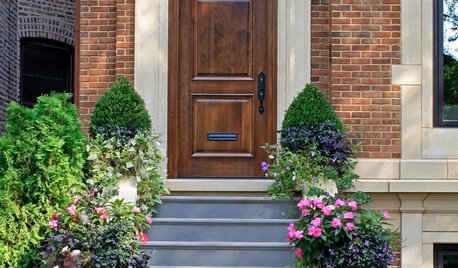






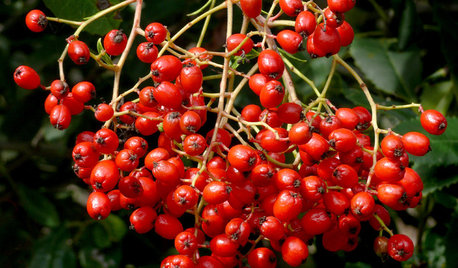







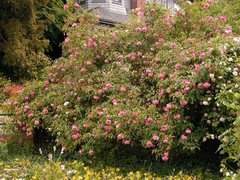
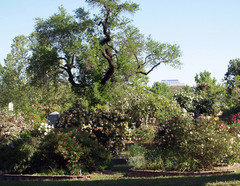
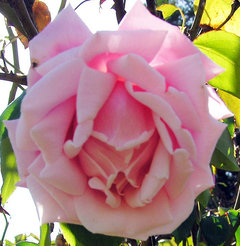
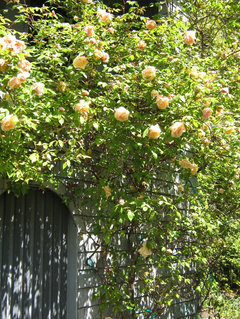
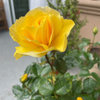


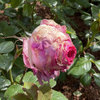
dublinbay z6 (KS)